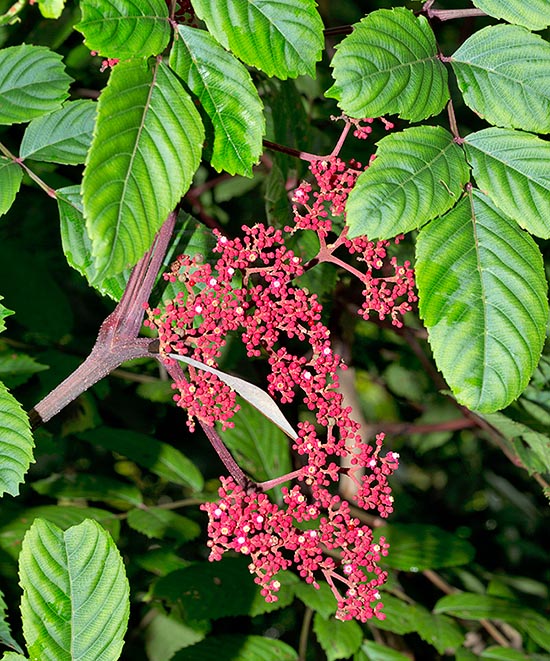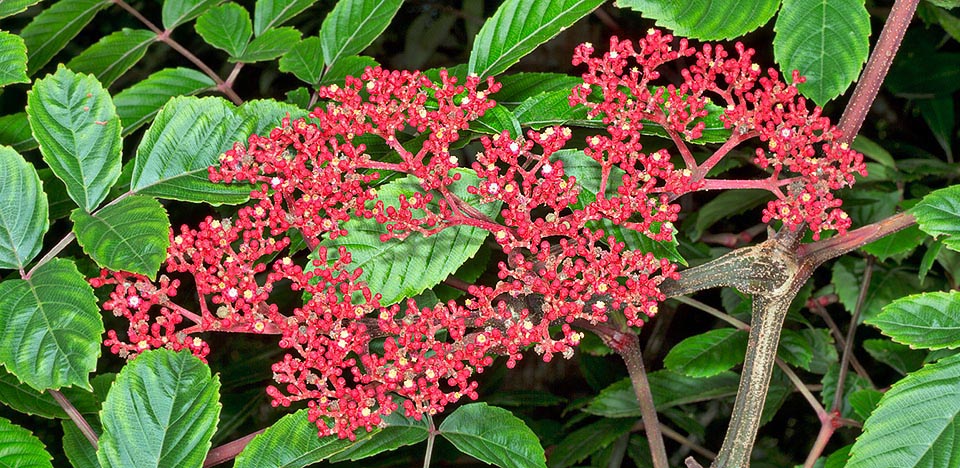Family : Vitaceae

Text © Pietro Puccio

English translation by Mario Beltramini

Native to Australia and South-East Asia, Leea rubra is a semiwoody 1-3 m shrub © G. Mazza
The genus is honoured to the Scottish botanist and nurseryman James Lee (1715-1795); the specific name is the Latin adjective “ruber, -bra, -brum” = red, with obvious reference.
Common names: red tree shrub (English); bay kdang, daem kdang bay (Cambodian); girang (Javanese); tang khai, daem kdang bay (Lao); mali puchok merah (Malay); léia-rubra, léia-vermelha (Portuguese-Brazil); ginggijan beureum (Sundanese); katangbai, khueang (Thai); cây gối hạc, củ rối, cây mũn, đơn gối hạc, gối hạc tía, (Vietnamese).
The Leea rubra Blume ex Spreng. (1824) is an evergreen semiwoody shrub, 1-3 m tall, with leaves, on a 4-20 cm petiole, alternate, 20-50 cm long, 2-4 pinnate with 5-7 subsessile leaflets per pinnule, oblong-lanceolate to elliptic with pointed apex and serrate margins, 3-14 cm long and 1,5-5 cm broad, of dark green colour; the rachis is red.
The inflorescences on a 3-6 cm long peduncle from the opposite side of the leaf, are compact cymes, 5-15 cm long, carrying a crowd of hermaphroditic flowers of about 5 mm of diameter.
Campanulate red calyx with triangular lobes, corolla with 2-3 mm long tube and 5 lobes merged at the base, about 2 mm long, retroflexed, of red colour outside, pinky inside, and 5 stamina united at the base to form a 1-2 mm long tube; peduncle, rachis and pedicels are covered by rusty red tomentum. The fruits are subglobose berries of about 1 cm of diameter with persistent calyx, initially green, then red and finally blackish purple when ripe, containing 4-6 globose seeds of 4 mm of diameter.
It reproduces by seed, in draining organic loam maintained humid at the temperature of 24-26 °C, and by cutting in spring.
Much ornamental species due to the foliage and the inflorescences, always utilizable as isolated specimen, in group or for fences in parks and gardens exclusively in the tropical and subtropical climates, not bearing temperatures close to 0° C, if not exceptional and of very short duration.

The inflorescences on 3-6 cm long peduncle from the opposite side of the leaf, are compact cymes, 5-15 cm long, bearing a crowd of hermaphrodite flowers of about 5 mm of diameter. All parts of the plant are toxic; leaves and roots are used in the traditional medicine for various pathologies © Giuseppe Mazza
It bears the full sun, but grows best in semi-shaded position, and is not particular about the soil, provided fertile, draining and maintained almst constantly humid; useful are priodical renewal prunings. It grows well in pot and is since time utilized for the decoration of luminous inner spaces, even out from the tropical and subtropical zones, with lowest night minimum temperatures not under the 16 °C, regular waterings in summer, more spaced in winter, but without ever allowing the substratum to dry up completely, and fertilizations in spring-summer with balanced products with microelements.
All parts of the plant are toxic; leaves and roots are used in the traditional medicine for various pathologies.
Synonyms: Leea polyphylla Miq. (1859); Leea rubra var. apiifolia Zipp. ex Miq. (1863); Leea rubra var. polyphylla (Miq.) Miq. (1853); Leea brunoninan C.B. Clarke (1881); Leea linearifolia C.B. Clarke (1881); Leea rubra f. celebica Koord. (1898).
→ To appreciate the biodiversity within VITACEAE family please click here.
